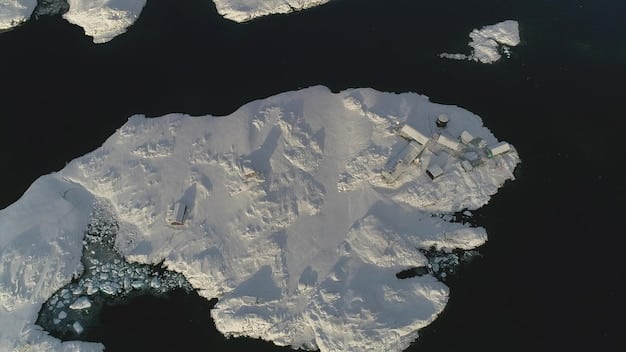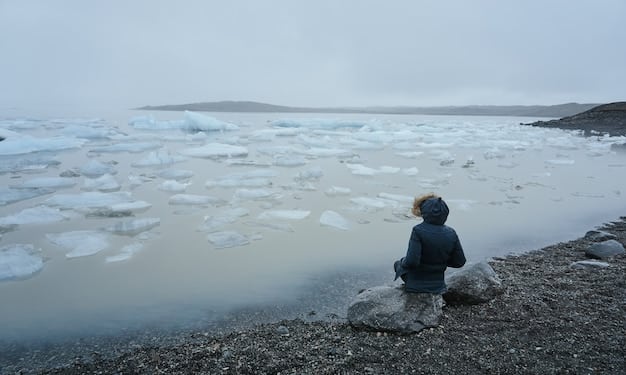Emerging Threats to US National Security in the Arctic Region

Advertisements
Examining the evolving geopolitical landscape and environmental shifts, this article dives deep into the multifaceted challenges confronting U.S. national security interests in the Arctic, from heightened military competition to the impacts of climate change on strategic infrastructure.
Advertisements
As the Earth’s northern reaches undergo unprecedented transformation, the question of What are the Emerging Threats to US National Security in the Arctic Region? becomes increasingly critical. This pivotal area, once frozen in relative obscurity, is now a stage for complex geopolitical maneuvers and environmental shifts, demanding a fresh look at America’s strategic vulnerabilities and interests.
The Geopolitical Chessboard: Shifting Power Dynamics
The Arctic, traditionally a frozen frontier, is rapidly becoming a thawing chessboard where major global powers are vying for influence. This strategic thawing, driven by climate change opening up new shipping routes and access to resources, fundamentally alters the geopolitical calculus for nations like the United States. The region’s vast, untapped reserves of oil, natural gas, and rare earth minerals, alongside its potential as a shorter transit route between Asia, Europe, and North America, make it an economic prize. However, these opportunities are intertwined with significant security implications, as competition intensifies and military footprints expand.
Advertisements
The allure of economic gain fuels increased military presence and strategic posturing from Arctic and non-Arctic states alike. Russia, with its extensive Arctic coastline, has long considered the region vital to its national security and economic future, investing heavily in military modernization and infrastructure. This includes the revitalization of Soviet-era bases, deployment of advanced weaponry, and construction of new icebreaking fleets. China, while not an Arctic nation, has declared itself a “near-Arctic state” and is actively pursuing its “Polar Silk Road” initiative, blending economic investment with strategic access.
Russia’s Revitalized Arctic Military Presence
Russia’s comprehensive modernization of its Arctic military capabilities poses a direct challenge to the U.S. and its allies. The buildup is not merely defensive but aims to solidify Russia’s control over its Northern Sea Route and project power across the region. This involves cutting-edge developments and deployments.
- Icebreaker Fleet: Russia possesses the world’s largest fleet of nuclear-powered icebreakers, crucial for year-round navigation and asserting sovereignty.
- Military Bases: Reactivation and expansion of numerous military bases and airfields along its Arctic coast, enhancing operational reach.
- Advanced Weaponry: Deployment of advanced missile systems, including hypersonic weapons, designed to operate in extreme Arctic conditions.
These actions create a dual-use capability – facilitating resource extraction and commercial shipping while simultaneously enabling military dominance. The U.S. must grapple with how to counter these advancements without escalating tensions, focusing on maintaining freedom of navigation and upholding international law.
China’s Growing Arctic Ambitions
China’s involvement in the Arctic, though primarily economic, carries significant strategic undertones. Its investments in Arctic energy, mining, and infrastructure projects, particularly in Russia and Greenland, raise concerns about data security, control over critical resources, and potential dual-use applications of infrastructure. Beijing’s articulation of a “Polar Silk Road” strategy is a clear signal of its long-term intent.
The increasing presence of non-Arctic states, especially China, complicates the security environment. Their motivations, while often framed economically, can also serve to extend geopolitical influence and potentially challenge existing norms and governance frameworks. For the U.S., understanding and responding to these nuanced threats requires a robust diplomatic and strategic approach, alongside a reassessment of its own Arctic capabilities and investments.
The evolving geopolitical chessboard in the Arctic necessitates a nuanced and proactive U.S. strategy. It’s not just about military strength, but also about reinforcing international cooperation, technological superiority, and resilient infrastructure. The stakes involve not only regional control but global stability and economic prosperity.
Climate Change and its Strategic Ramifications
The Arctic is warming at a rate significantly faster than the rest of the planet, leading to profound environmental changes with far-reaching strategic consequences for U.S. national security. The melting ice caps are not merely an environmental concern but a catalyst for new geopolitical realities, opening up previously inaccessible areas to human activity, commerce, and potential conflict. This rapid transformation impacts everything from maritime access to defense infrastructure, creating a cascade of interconnected challenges that demand immediate and long-term attention.
The receding ice fundamentally alters shipping routes, making the Northern Sea Route and the Northwest Passage more navigable for longer periods. While this presents economic opportunities for shorter global shipping lanes, it also introduces new security vulnerabilities. Increased maritime traffic expands the potential for accidents, environmental disasters, and illicit activities, requiring enhanced search and rescue capabilities, environmental monitoring, and law enforcement presence. The U.S. Coast Guard, already thinly stretched, faces an unprecedented demand for its services in a remote and unforgiving environment.
Opening of New Maritime Routes
The navigability of Arctic routes is a double-edged sword. On one hand, it promises reduced transit times and fuel costs for commercial shipping. On the other, it introduces new challenges for surveillance, sovereignty, and security.
- Increased Shipping: More vessels, including commercial cargo ships, cruise liners, and potentially military vessels, traversing once-impenetrable waters.
- Sovereignty Disputes: Heightened contention over the legal status of passages like the Northwest Passage, which Canada considers internal waters, while the U.S. asserts it is an international strait.
- Environmental Risks: Greater potential for oil spills, pollution, and damage to fragile Arctic ecosystems from increased activity.
These new routes necessitate robust naval and coast guard capabilities to ensure freedom of navigation, respond to emergencies, and enforce international law. The U.S. must invest in versatile platforms capable of operating effectively in extreme cold and remote conditions.
Impact on Infrastructure and Ecosystems
The thawing permafrost, a direct consequence of climate change, poses significant threats to existing and planned infrastructure across the Arctic. Buildings, roads, pipelines, and military installations built on previously stable ground are now at risk of structural damage or collapse. This affects everything from communications networks to early warning systems, potentially compromising defense readiness and operational capabilities.
The broader environmental impact, including changes in wildlife migration patterns and ocean currents, also has security implications. Indigenous communities, whose livelihoods and cultures are intrinsically linked to the environment, face displacement and economic hardship, leading to potential humanitarian crises and requiring targeted interventions. The U.S. must consider the human security dimension of climate change, supporting resilience and adaptation efforts among Arctic populations.

The strategic ramifications of climate change in the Arctic are vast and complex, extending beyond traditional military considerations to encompass environmental, economic, and humanitarian dimensions. A comprehensive U.S. national security strategy for the Arctic must therefore integrate climate science, innovative technologies, and international cooperation to mitigate risks and capitalize on emerging opportunities.
Military Buildup and Strategic Competition
The Arctic’s strategic importance has accelerated a military buildup among various nations, transforming the region into a hotbed of potential strategic competition. This shift is characterized by increased military exercises, modernization of forces, and the development of specialized Arctic capabilities. The U.S., while having a significant presence, faces challenges in matching the speed and scale of developments by other major players, particularly Russia, and to a lesser extent, China. The concern isn’t just about direct conflict but also about the potential for miscalculation, escalation, and the erosion of regional stability, as nations assert their claims and project power.
The militarization extends to various domains: air, sea, and land. Naval patrols are becoming more frequent, air forces are conducting more extensive reconnaissance and training flights, and ground forces are developing specialized equipment and tactics for cold-weather operations. This surge in activity necessitates a re-evaluation of military doctrines, investment in advanced platforms, and strengthening of alliances to deter aggression and maintain a favorable balance of power. The U.S. approach must balance deterrence with diplomacy, ensuring that its military posture remains robust while advocating for peaceful resolutions to disputes.
Naval and Air Force Projections
The U.S. naval and air forces are crucial for maintaining presence, conducting surveillance, and projecting power in the Arctic. However, operating in the extreme conditions presents unique challenges requiring specialized capabilities and training.
- Ice-Capable Ships: Limited fleet of icebreakers and hardened vessels, a critical capability gap compared to Russia.
- Long-Range Patrols: Need for more frequent and extended air patrols over Arctic waters to monitor activity and gather intelligence.
- Basing and Logistics: Challenges in maintaining robust logistics and support infrastructure in remote Arctic locations.
Addressing these gaps requires significant investment in new platforms, technology, and personnel training. Enhancing interoperability with allies like Canada, Norway, and Denmark is also vital for collective security.
Ballistic Missile Defense Concerns
The Arctic’s geographical position makes it a critical area for ballistic missile defense. The shortest flight paths for intercontinental ballistic missiles (ICBMs) between major powers often traverse the Arctic. This makes early warning systems, radar installations, and missile interceptor sites in the region paramount for national defense. The U.S. and its allies rely on these systems to detect, track, and potentially intercept incoming threats. However, the harsh Arctic environment poses significant challenges to the reliability and maintainability of these sophisticated systems, requiring specialized engineering and protective measures against extreme cold, ice, and electromagnetic interference. The increasing sophistication of missile technology, including hypersonic capabilities, further complicates the defensive calculus, demanding continuous research and development to stay ahead of emerging threats.
Moreover, the deployment of such systems in the Arctic can be perceived by rival nations as escalatory, leading to a security dilemma where one nation’s defensive measures are seen as offensive by another. This highlights the delicate balance between necessary defense and inadvertently increasing regional tensions. Diplomatic channels must remain open to manage these perceptions and prevent unintended escalation. The military buildup in the Arctic, while driven by legitimate national security concerns, necessitates careful strategic planning to avoid transforming a harsh but peaceful frontier into a new zone of great power conflict. Building resilience and maintaining deterrence requires a balanced approach of military readiness, technological innovation, and steadfast diplomatic engagement with all Arctic stakeholders.
Cyber Warfare and Critical Infrastructure Vulnerabilities
As the Arctic becomes increasingly accessible and economically vital, it also emerges as a new front in the global cyber arms race. The reliance on advanced digital technologies for communication, navigation, research, and resource extraction creates numerous vulnerabilities to cyber warfare and attacks on critical infrastructure. From satellite communication networks essential for remote operations to industrial control systems managing energy pipelines and port facilities, a successful cyberattack in the Arctic could have catastrophic consequences, disrupting vital services, endangering lives, and compromising national security. The extreme environment further complicates the challenge, as physical access for repairs or maintenance is often severely limited, making remote cyber defenses even more crucial.
The perpetrators of such cyber threats can range from state-sponsored actors seeking to gain strategic advantages or sow disruption, to non-state actors pursuing economic gain or political objectives. The global interconnectedness means that an attack originating far from the Arctic could nonetheless have devastating impacts within the region, highlighting the transnational nature of cyber threats. For the U.S., protecting its Arctic interests against these evolving cyber risks requires a multi-layered defense strategy—one that integrates robust cybersecurity protocols, advanced threat intelligence, and international cooperation to build collective resilience and deter malicious actors.
Protecting Arctic Communications Networks
Communication networks are the lifeblood of Arctic operations, enabling everything from scientific research to military command and control. These networks, often satellite-dependent due to the remote terrain, are particularly susceptible to cyber interference and jamming.
- Satellite Vulnerabilities: Reliance on vulnerable ground stations and satellite links susceptible to denial-of-service attacks or spoofing.
- Fiber Optic Cables: While more secure, their deployment in the harsh Arctic environment is challenging and expensive, creating infrastructure gaps.
- Emerging Technologies: Need for secure and resilient next-generation communication systems, including quantum-resistant encryption.
Ensuring the integrity and availability of these networks is paramount. Investment in diversified communication channels, redundant systems, and advanced encryption is critical to mitigate cyber risks and maintain operational continuity in the face of attack.
Safeguarding Resource Extraction and Transportation
The Arctic’s vast natural resources drive significant economic activity, making resource extraction and transportation infrastructure prime targets for cyberattacks. The industrial control systems (ICS) and operational technology (OT) that manage oil and gas pipelines, mining operations, and shipping logistics are often legacy systems not designed with modern cybersecurity in mind, making them particularly vulnerable.
A cyberattack on a pipeline, for example, could lead to a massive environmental disaster, while disrupting port operations could cripple supply lines. The U.S. must work collaboratively with industry to implement rigorous cybersecurity standards, conduct regular vulnerability assessments, and develop rapid response capabilities to contain and recover from incidents. This includes training a specialized workforce capable of defending against sophisticated cyber threats in unique Arctic operational environments. The confluence of climate change, increased human activity, and geopolitical competition amplifies the stakes for cybersecurity in the Arctic. Robust cyber defenses are not merely a technical requirement but a strategic imperative to safeguard national interests, protect critical infrastructure, and maintain stability in a rapidly changing polar region.
Search and Rescue Challenges in a Vast Frontier
The increasing human activity in the Arctic, driven by expanding shipping lanes, resource exploration, and tourism, inevitably leads to a heightened risk of accidents and emergencies. However, the region’s extreme remoteness, harsh weather conditions, vast distances, and limited infrastructure pose monumental challenges for effective search and rescue (SAR) operations. Unlike more populated areas, the Arctic lacks readily available SAR assets, advanced communication networks, and medical facilities, turning routine incidents into potentially catastrophic events. This creates a significant national security threat, as the U.S. bears responsibility for its citizens and contributes to international SAR efforts, often relying on international agreements due to the sheer scale of the region.
The sheer unpredictability of the Arctic environment—from sudden blizzards and rapidly shifting ice to extreme cold and prolonged darkness—makes any SAR mission inherently dangerous and complex. The time window for survival in these conditions is often very short, demanding swift and highly coordinated responses. The capability to project SAR assets, including specialized aircraft, ice-capable vessels, and trained personnel, across vast and unforgiving terrain, often with limited navigational aids, is a severe test of any nation’s Arctic readiness. The U.S. must therefore continuously assess and enhance its SAR capabilities, investing in specialized equipment, advanced training, and robust international partnerships.
Limited Infrastructure and Harsh Conditions
The absence of critical infrastructure significantly hampers SAR efforts in the Arctic. This includes everything from lack of deep-water ports suitable for large rescue vessels to limited airfields for fixed-wing aircraft and insufficient communication coverage.
- Remote Deployments: Challenges in rapidly deploying assets and personnel to distant incident sites.
- Weather Constraints: Extreme cold, blizzards, and prolonged periods of darkness limit operational windows for SAR teams.
- Navigation Difficulties: Dynamic ice conditions and sparse charting make navigation hazardous for both rescue vessels and aircraft.
These limitations underscore the necessity for innovative solutions, such as deploying unmanned aerial vehicles (UAVs) for reconnaissance, and investing in all-weather, multi-mission platforms capable of enduring Arctic conditions.
International Cooperation and Capacity Gaps
Given the immense scope and severity of potential incidents, no single nation can adequately cover the entire Arctic region for SAR purposes. International cooperation is therefore not merely beneficial but absolutely essential. The 2011 Arctic Search and Rescue Agreement among the eight Arctic states provides a framework for collaboration, but significant capacity gaps remain. Nations, including the U.S., need to bolster their own capabilities while strengthening interoperability with partners.
This includes joint training exercises, sharing of best practices, and developing common protocols. Ensuring that each Arctic nation has sufficient resources—ice-capable ships, long-range aircraft, specialized medical teams, and reliable communication systems—is critical for a robust regional SAR network. The U.S. needs to lead in fostering these collaborative efforts, recognizing that effective SAR capabilities serve not only humanitarian goals but also underpin maritime security and stability in the burgeoning Arctic region. Addressing these SAR challenges is a testament to a nation’s commitment to responsible Arctic stewardship and international cooperation.
Resource Exploitation and Environmental Degradation
The opening of the Arctic due to climate change presents significant opportunities for resource exploitation, particularly in oil, natural gas, and strategic minerals. However, this pursuit of economic gain brings with it the risk of severe environmental degradation, which paradoxically poses its own set of national security threats. The Arctic ecosystem is incredibly fragile and slow to recover from damage, making it highly susceptible to the impacts of industrial activity. An oil spill in these extreme conditions, for instance, would be far more challenging to clean up than in temperate waters, potentially leading to long-term ecological devastation and undermining the livelihoods of indigenous communities.
The scramble for resources can also exacerbate geopolitical tensions. As nations assert claims over areas rich in minerals or hydrocarbons, the potential for disputes over territorial rights and economic zones increases. This competition can escalate, drawing in military assets and raising the specter of conflict. For the U.S., balancing economic interests with environmental stewardship and security concerns in the Arctic is a delicate act. It requires robust regulatory frameworks, advanced technologies for safe operations, and a steadfast commitment to international environmental agreements to prevent unintended consequences.
Oil and Gas Exploration Risks
The vast, untapped oil and gas reserves beneath the Arctic seabed are a major draw for energy companies, but their extraction carries inherent and magnified risks in the polar environment.
- Spill Response: Limited infrastructure and harsh weather make oil spill containment and cleanup exceptionally difficult, if not impossible, especially under ice.
- Ecological Impact: Damage to unique and sensitive marine and terrestrial ecosystems, affecting wildlife and Indigenous subsistence practices.
- Operational Safety: Extreme conditions increase the risk of equipment failure and human error during drilling and transport operations.
These risks necessitate stringent safety regulations, robust environmental impact assessments, and proven spill response capabilities before large-scale exploration proceeds. The U.S. must prioritize responsible development over rapid exploitation.
Impact on Indigenous Communities and Livelihoods
Indigenous communities have inhabited the Arctic for millennia, their cultures and livelihoods inextricably linked to the health of the environment. Resource exploitation and environmental changes directly threaten their traditional ways of life, leading to significant social and economic disruption. This impact includes not only pollution but also changes in hunting and fishing grounds, displacement from ancestral lands, and erosion of cultural heritage. When these communities are destabilized, it create human security challenges, potentially leading to social unrest and requiring humanitarian assistance, which can draw on national resources and attention.

Engaging these communities in planning and decision-making processes is crucial for ensuring sustainable development and respecting their rights. Furthermore, protecting their traditional wisdom and environmental knowledge can provide invaluable insights into adapting to Arctic changes. The U.S.’s national security interests in the Arctic are not solely about military might or economic gain; they also encompass the well-being of the region’s people and the preservation of its unique environment. Ensuring responsible resource management and mitigating environmental degradation are therefore vital components of a comprehensive Arctic strategy, preventing localized issues from escalating into broader security challenges.
The U.S. Response: Strategy, Investment, and Diplomacy
In the face of these multiplying threats, the United States is actively refining its approach to the Arctic, recognizing that a comprehensive strategy is essential to safeguard its national security interests. This involves a multifaceted response that balances military readiness with diplomatic engagement, strategic investments, and a commitment to international law and environmental stewardship. The challenges posed by geopolitical competition, climate change, and the unique operational environment demand a cohesive and long-term vision, moving beyond episodic attention to sustained, strategic commitment. The goal is not merely to react to threats but to proactively shape a stable, secure, and prosperous Arctic region under conditions favorable to U.S. interests and those of its allies.
A core pillar of this response is enhancing military capabilities, which includes investing in ice-capable naval assets, modernizing infrastructure, and conducting robust training exercises adapted to Arctic conditions. However, military strength alone is insufficient. Diplomacy plays an equally critical role in maintaining international norms of conduct, resolving potential disputes peacefully, and fostering cooperation on shared challenges such as search and rescue, scientific research, and environmental protection. Building and strengthening alliances with fellow Arctic nations and other committed stakeholders is paramount to ensure collective security and resilience against emerging threats. The U.S. approach emphasizes collaboration over confrontation, while maintaining the capacity for deterrence.
Rebuilding Arctic Capabilities and Presence
For decades, U.S. Arctic capabilities lagged behind those of some rivals, especially Russia. A renewed focus involves significant investment to close these gaps and enhance the U.S. presence across the region.
- Icebreaker Fleet Expansion: Prioritizing the construction of new heavy icebreakers to ensure year-round access and operational capacity.
- Infrastructure Modernization: Upgrading ports, airfields, and communications networks in Alaska and other strategic locations.
- Personnel Training: Enhancing cold-weather training for military personnel to operate effectively in extreme environments.
These investments are vital for ensuring the U.S. can project power, conduct surveillance, and respond to contingencies across the vast Arctic domain.
Strengthening Alliances and International Norms
Collaboration with allies and partners is a cornerstone of U.S. Arctic strategy. This includes working closely with fellow Arctic Council members (Canada, Denmark/Greenland, Finland, Iceland, Norway, Sweden) and non-Arctic allies like the UK and France, who also have interests in the region. The aim is to uphold a rules-based international order, promote freedom of navigation, and ensure transparent conduct.
Further strengthening the Arctic Council as a forum for cooperation on environmental protection and sustainable development is also crucial, providing a de-escalatory platform. The U.S. must also champion scientific research and data sharing, as a deeper understanding of the Arctic environment and its changes is fundamental to informed decision-making and adaptive strategies. Ultimately, the U.S. response to the emerging threats in the Arctic is not just about defending borders, but about shaping a challenging, yet potentially prosperous, future for this globally critical region through a blend of measured strength, proactive diplomacy, and collaborative leadership.
| Key Area | Brief Description of Threat |
|---|---|
| 🌎 Geopolitical Shifts | Increased competition and militarization from Russia and China for strategic advantage and resources. |
| 🌡️ Climate Impacts | Melting ice opens new routes but degrades infrastructure and complicates operations. |
| 💡 Cyber Vulnerabilities | Threats to critical communication and industrial control systems in remote Arctic environments. |
| 🆘 SAR Challenges | Vast distances and harsh conditions hinder effective search and rescue operations. |
Frequently Asked Questions About Arctic Security
The Arctic’s importance has surged due to rapid climate change melting ice, opening new navigation routes and revealing vast untapped natural resources. This has intensified geopolitical competition among nations like Russia, China, and the U.S., each seeking strategic advantages and economic benefits in the newly accessible region, directly impacting global stability and resource security.
Climate change in the Arctic directly impacts U.S. security by causing permafrost thaw, which threatens crucial infrastructure like military bases and communication systems. It also creates new, more navigable shipping lanes, increasing maritime traffic and the potential for accidents, sovereign disputes, and illicit activities, demanding enhanced U.S. naval and coast guard capabilities.
Russia is significantly increasing its military presence, reactivating Soviet-era bases, and deploying advanced weaponry to secure its Arctic coastline and Northern Sea Route dominance. China, as a “near-Arctic state,” is pursuing economic initiatives like the “Polar Silk Road,” investing in infrastructure and resources, which could expand its strategic influence, posing both economic and security challenges.
Primary search and rescue challenges in the Arctic stem from its extreme remoteness, harsh weather, vast distances, and limited infrastructure. These factors complicate rapid deployment of assets, communication, and medical aid, shortening survival times. International cooperation, despite agreements, remains critical due to the scale of the region and existing capacity gaps among nations.
The U.S. is addressing these threats through a multi-faceted strategy focused on enhancing military capabilities, including icebreaker fleet expansion and infrastructure modernization. It also emphasizes strengthening alliances and international norms through diplomatic engagement, ensuring freedom of navigation, upholding a rules-based order, and promoting environmental stewardship to maintain stability and security.
Conclusion: Navigating the New Arctic Frontier
The Arctic, once a peripheral concern, has rapidly ascended to the forefront of U.S. national security priorities. The confluence of a rapidly changing climate, fierce geopolitical competition, and the inherent challenges of operating in an extreme environment creates a complex tapestry of emerging threats. From Russia’s military resurgence and China’s expanding economic footprint to the vulnerabilities of critical infrastructure to cyberattacks and the monumental challenges of search and rescue, the stakes in the Arctic are undeniably high. The future of this critical region will undoubtedly be shaped by how effectively nations, particularly the United States, navigate these intricate dynamics. It necessitates a strategy that is not only militarily robust but also diplomatically agile, environmentally conscious, and deeply committed to fostering international cooperation. As the ice continues to recede, revealing both opportunities and dangers, the U.S. commitment to a stable, secure, and sustainably managed Arctic will be paramount for its own national interests and global stability.





